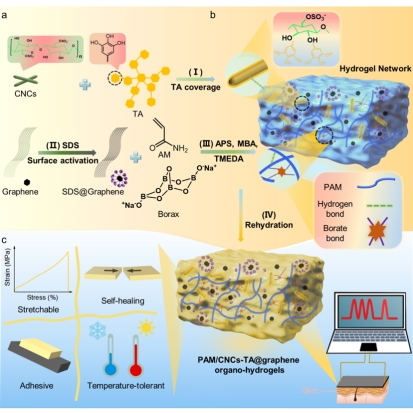Recently, Associate Professor Han Linbo's team at our university published a paper in Chemical Engineering Journal (Q1, IF:16.744) titled "Nanomaterials-enhanced, stretchable, self-healing, temperature-tolerant and adhesive tough organohydrogels with long-term durability as flexible sensors for intelligent motion-speech recognition." Shenzhen Technology University is the only corresponding unit, and our university's master student Qin Tao is the first author, while Associate Professor Han Linbo is the only corresponding author.
Flexible sensors have shown great potential in applications such as human motion and health monitoring, wearable electronic devices, electronic skin, and human-machine interaction, providing a strong impetus for the future development of flexible wearable devices. Compared to traditional sensors, flexible sensors based on conductive hydrogels exhibit good adjustability (components, mechanical properties, adhesion performance, etc.), biocompatibility, high sensitivity, and high accuracy. Conductive hydrogel is a new type of flexible sensing material; however, its sensing sensitivity and stability are often limited by problems such as unstable mechanical properties and solvent volatilization. Based on this, this paper constructed a flexible sensing material with self-healing properties, self-adhesion, high sensitivity, and a wide applicable temperature range through biomimetic component design and organic solvent substitution methods. As shown in Figure 1, a temperature-resistant, super-stretchable, self-adhesive, and tough conductive organic hydrogel was developed through in-situ free radical polymerization and ethylene glycol solvent substitution. The sensors based on conductive organic hydrogel exhibit excellent reliability and a wide sensing range and can accurately monitor physiological signals such as joint movement, wrist pulse, micro-expression, and sound.

Figure 1. The preparation schematic of organic hydrogel
Thanks to the satisfactory sensitivity of the organohydrogel sensors in motion and speech detection, they have great potential applications in intelligent motion recognition, such as correcting movement postures. As shown in Figure 2, by installing sensors with sensing characteristics on the vocal cords and motion monitoring wristbands, a simple speech/motion recognition platform can be constructed. The strain sensor at the vocal cords can record voice commands in real time and correspond them with pre-recorded motion signals. After an athlete completes a motion, the corresponding motion signal will be recorded in real time, compared with the pre-recorded waveform, and used to provide feedback on whether the posture during the motion is correct or not.

Figure 2. Real-time monitoring schematic of speech commands and motion signals.
Link to the paper:https://doi.org/10.1016/j.cej.2023.141905